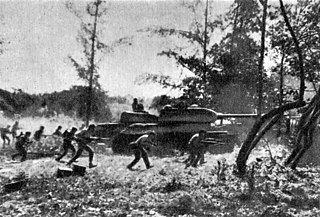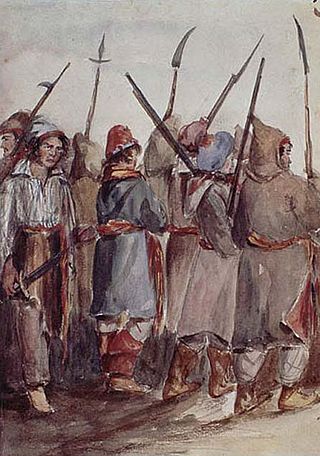
The Ethiopian National Defense Force (ENDF) is the military force of Ethiopia. Civilian control of the military is carried out through the Ministry of Defense, which oversees the Ground Forces, Air Force, Naval Force as well as the Defense Industry Sector.

A militia is generally an army or some other fighting organization of non-professional and/or part-time soldiers; citizens of a country, or subjects of a state, who may perform military service during a time of need, as opposed to a professional force of regular, full-time military personnel; or, historically, to members of a warrior-nobility class. When acting independently militias are generally unable to hold ground against regular forces; militias commonly support regular troops by skirmishing, holding fortifications, or conducting irregular warfare, instead of undertaking offensive campaigns by themselves. Local civilian laws often limit militias to serve only in their home region, and to serve only for a limited time; this further reduces their use in long military campaigns. Militias may also, however, serve as a pool of available manpower for regular forces to draw from, particularly in emergencies.
The Nicaraguan Armed Forces are the military forces of Nicaragua. There are three branches: the Navy, the Army, and Air Force.

The Cuban Revolutionary Armed Forces are the military forces of Cuba. They include army, navy, air force, and other paramilitary bodies including the Territorial Troops Militia, Youth Labor Army, and the Defense and Production Brigades, plus the Civil Defense Organization and the National Reserves Institution. All these groups are subordinated to the Ministro de las Fuerzas Armadas Revolucionarias.

The Bay of Pigs Invasion was a failed military landing operation on the southwestern coast of Cuba in 1961 by Cuban Democratic Revolutionary Front (DRF), consisting of Cuban exiles who opposed Fidel Castro's Cuban Revolution, covertly financed and directed by the U.S. government. The operation took place at the height of the Cold War, and its failure influenced relations between Cuba, the United States, and the Soviet Union.

Irregular military is any non-standard military component that is distinct from a country's national armed forces. Being defined by exclusion, there is significant variance in what comes under the term. It can refer to the type of military organization, or to the type of tactics used. An irregular military organization is one which is not part of the regular army organization. Without standard military unit organization, various more general names are often used; such organizations may be called a troop, group, unit, column, band, or force. Irregulars are soldiers or warriors that are members of these organizations, or are members of special military units that employ irregular military tactics. This also applies to irregular infantry and irregular cavalry units.
The ranks of the Cuban Revolutionary Armed Forces are the military insignia used by the Cuban military.
Corps General Julio Casas Regueiro was a Cuban politician. He was a vice-president of the Council of State and the Minister of Defense.

The Sandinista Popular Army (SPA) was the military forces established in 1979 by the new Sandinista government of Nicaragua to replace the Nicaraguan National Guard, following the overthrow of Anastasio Somoza Debayle.
The Central American crisis began in the late 1970s, when major civil wars and communist revolutions erupted in various countries in Central America, causing it to become the world's most volatile region in terms of socioeconomic change. In particular, the United States feared that victories by communist forces would cause South America to become isolated from the United States if the governments of the Central American countries were overthrown and pro-Soviet communist governments were installed in their place. During these civil wars, the United States pursued its interests by supporting right-wing governments against left-wing guerrillas.
The paramilitary forces of China are the military units and formations apart from the People's Liberation Army, the principal military force of the People's Republic of China. They are composed of three main forces, the People's Liberation Army reserve force, the People's Armed Police (PAP), and the Militia, and they act as auxiliaries to the active forces of the People's Liberation Army. They generally perform a wide range of roles. All together, the paramilitary has 20,854,000 troops, as of 2018.

The People's Armed Forces of Liberation of Angola or FAPLA was originally the armed wing of the People's Movement for the Liberation of Angola (MPLA) but later (1975–1991) became Angola's official armed forces when the MPLA took control of the government.

The Iraqi Popular Army also known as the People's Army or People's Militia was a paramilitary organization composed of civilian volunteers to protect the Ba'ath regime against internal opposition and serve as a counterbalance against any coup attempt by the regular Iraqi Army.
Territorial Defense or Territorial Defense Forces may refer to:

The CIA Tibetan program was an anti-Chinese covert operation spanning almost twenty years. It consisted of "political action, propaganda, paramilitary and intelligence operations" facilitated by arrangements made with brothers of the 14th Dalai Lama, who himself was not initially aware of them. The stated goal of the program was "to keep the political concept of an autonomous Tibet alive within Tibet and among several foreign nations". The program was admininstrated by the CIA, and unofficially operated in coordination with domestic agencies such as the Department of State and the Department of Defense.
The National Revolutionary Militia (MNR) is a citizens’ militia in the Republic of Cuba. It was founded in 1959 in the aftermath of the Cuban Revolution to protect buildings against sabotage from "counter-revolutionary" armed groups and any external threat of intervention. Under the command of Cuban Revolutionary Armed Forces (FAR), it was a voluntary group which served as a way to ensure widespread participation in the revolution. While MNR members were often assigned noncombat tasks, they played an important role on the frontline during the Bay of Pigs invasion in 1961 and defeating the 1958-1965 Escambray Rebellion.
The Day of the Cuban Armed Forces is a national holiday in Cuba celebrated annually on December 2 commemorating the landing of the Granma which brought the Castro brothers and their supporters from Mexico to Cuba to start their revolution against the Batista Regime. The event is marked by military parades, fireworks and concerts throughout the country.

Tanks have been utilized on the island of Cuba both within the military and within several conflicts, with their usage and origin after World War II; the Cold War; and the modern era. This includes imported Soviet tanks in the Cuban Revolutionary Armed Forces today as well as American and British designs imported prior to the Cuban Revolution.
Máximo Gómez Command Academy is a military institution of the Cuban Revolutionary Armed Forces. The academy, which is located to the east of Havana, is the principal senior service school for the training of soldiers in the FAR. It currently bears the name of Major General Máximo Gómez, who was a 19th century Cuban independence fighter. It was founded in 1963 and is under the orbit of the Ministry of the Revolutionary Armed Forces (MINFAR), whose employees are trained by the school. The command academy has been decorated with many military and state awards such as the Order of Antonio Maceo and the Order of Carlos J. Finlay.

The Avispas Negras (English: Black Wasps), also known formally as the Mobile Brigade of Special Troops (BMTE) is a special forces unit in the Cuban Revolutionary Armed Forces. It is often identified as Military Unit 4895.









